The Campbell Clan (Click most images for larger versions.)
My brother, Buster, never talked much.
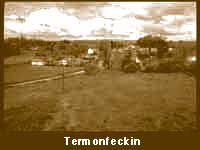 He especially never talked much about his stay in Ireland, except to say that he didn't want to leave when the time came—imagine how long those five years seemed to him. I'm sure Ireland felt like home by then; New York, frightening.
He especially never talked much about his stay in Ireland, except to say that he didn't want to leave when the time came—imagine how long those five years seemed to him. I'm sure Ireland felt like home by then; New York, frightening.
In Termonfeckin, the green fields seemed to go on forever—there were no fences. The beach lay close by, and there were hundreds of yards of hard, wet sand when the Irish Sea ebbed. It was a young boy's paradise—at least whenever Grandma Mary had no chores for him. No wonder he didn't want to leave when the time came.
Although I'm not really familiar with Buster's time in Termonfeckin, nor with our other Irish relatives there, my eldest son, Bob, and his wife, TC, uncovered some information when they visited in 1986.
They flew into Dublin to begin their two-week bicycling trip across Ireland. Their first stop, after leaving Dublin and stowing their rented bikes on the train to Drogheda, was a bed & breakfast in Termonfeckin, where they spent a few days digging up information about the Campbells. First, however, I guess I should relate Bob's tale of a leprechaun!
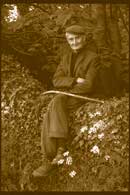 Once in Drogheda, TC and Bob climbed aboard their touring bikes for the eight kilometer ride to Termonfeckin. There was a light rain as they ventured out into the deep, luscious greens of the countryside—Bob wearing a blue rain-suit, TC a yellow. Their bikes were loaded down with panniers and handle bar bags, and they were riding into a stiff, bitter breeze. It would be a short ride, but an uncomfortable one. That is, until the rain stopped, the wind dropped and the sun broke through the clouds.
Once in Drogheda, TC and Bob climbed aboard their touring bikes for the eight kilometer ride to Termonfeckin. There was a light rain as they ventured out into the deep, luscious greens of the countryside—Bob wearing a blue rain-suit, TC a yellow. Their bikes were loaded down with panniers and handle bar bags, and they were riding into a stiff, bitter breeze. It would be a short ride, but an uncomfortable one. That is, until the rain stopped, the wind dropped and the sun broke through the clouds.
It was then, as they thankfully coasted through a long, sweeping bend in the rural lane, that they noticed an odd character sitting on an ivy-covered stone wall adjacent to the road. An old man sat haloed in green with a crooked stick across his lap, a cap cocked on his head, a threadbare suit hanging on his thin frame, and a knowing smile creasing his care-worn face. The man sat perfectly still, and perfectly dry, his eyes never leaving the young couple on their two-wheelers. He so struck Bob that, even in his wet misery, he decided he had to take a picture. So, he turned around, rode back, asked permission, then took the shot you see at the left. (You can click it for a larger version and the brief exchange between them.)
Bob told me that after their wonderful sunny days in Termonfeckin—as opposed to the cold, windy, rainy days on the remainder of their Irish ride—he began to think of the old man as a leprechaun, blessing their entry to the family seat. (Bob has always heard a different drummer.) My son also claimed, however, that the blessing is why they met a certain retired Irish Army captain, Michael Cumiskey, who not only remembered Buster in Ireland, but all the Campbell clan. (I'll admit their stay in Termonfeckin was special, and their meeting with the Captain most opportune, but I'm sorry, I don't believe in leprechauns. Besides, isn't he too big?)
Serendipitously, a woman living in Termonfeckin, Audrey Smith, read these pages in February 2009 and recognized the man on the wall. She only knew him as "The Major," but said he and a friend, Pete Kane—"...a couple of snuff sniffing charactors indeed!!"—used to drink with her mum and dad, Patsy and Tony Smith, in the 19th bar & lounge (it sits next to the County Louth Golf Club).
Audrey also wrote: "Many a great night was had in the 19th as everyone took a turn at singing. Many times there would be high tides and everyone would get stuck in the pub for hours, until the tide retreated so they could make their way home."
Declan Quaile, of the Termonfeckin Historical Society, offered this information: "The old man on the wall was John Mulroy, known as 'Major' by the locals. He died in 2000, aged 83, and was buried in Termonfeckin cemetery."
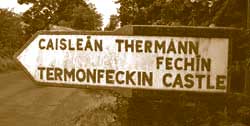 Termonfeckin (Tearmann Feichín or "Sanctuary of Feichin") has a small tower house castle built by some 15th or 16th century lord, and you admit and escort yourself through it. When Bob and TC visited, the keys to the castle were kept by Patrick Duff in his bungalow across the cul-de-sac. How did they know? A hand-written sign, hanging on the wrought iron gate said so. And, as fate would have it, Mr. Duff not only lent them the key, he also suggested they look up Capatin Cumiskey, because he was "...old enough to remember those times."
Termonfeckin (Tearmann Feichín or "Sanctuary of Feichin") has a small tower house castle built by some 15th or 16th century lord, and you admit and escort yourself through it. When Bob and TC visited, the keys to the castle were kept by Patrick Duff in his bungalow across the cul-de-sac. How did they know? A hand-written sign, hanging on the wrought iron gate said so. And, as fate would have it, Mr. Duff not only lent them the key, he also suggested they look up Capatin Cumiskey, because he was "...old enough to remember those times."
Anyway, when Bob and TC met Captain Cumiskey, he was dressed in suit and tie with a sporty hat. He thoroughly impressed the young couple. He was sharp, witty and very hospitable. In fact, the three of them spent a long morning talking in his parlor, sipping straight Irish whiskey(!), and sharing tales. Afterwards, the Captain drove them around Termonfeckin pointing out houses the Campbells had lived in, farmland they owned, and finally the family gravestone at the Port Cemetery in the Mayne District.
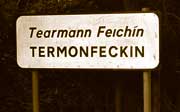 The Captain, himself, lived in a large old manor house in a village area called Yellow Gap—I don't know why. The house was as impressive, though weathered, as the Captain himself—my son described him as a "dapper, bantam rooster of a man," resembling the late actor, Barry Fitzgerald, and the house as a "two-story, columned manse."
The Captain, himself, lived in a large old manor house in a village area called Yellow Gap—I don't know why. The house was as impressive, though weathered, as the Captain himself—my son described him as a "dapper, bantam rooster of a man," resembling the late actor, Barry Fitzgerald, and the house as a "two-story, columned manse."
The Captain was born around the turn of the century, closest in age to my Uncle William, yet still "as lucid and quick as the day is long." My son told me that the Captain had them in stitches more often than not.
(Click HERE for an article on Captain Cumiskey that ran in the 2008 issue of the Termonfeckin Historical Society Review.)
Not only did he tell many stories about the older Campbells, he also remembered Grandma Mary's loud yelling when she wanted Buster to come home:
"You could hear her caterwauling all over the village," the Captain recalled, "so loud everyone did everything they could to get Buster back home so she'd shut her yap. But we didn't call him Buster. I can't quite remember what we called him, although I think it was Wee Willie 'cause he reminded us so much of his Great-uncle Willie, who went to the Navy."
According to Captain Cumiskey, Buster was a square peg in a round Irish hole when he first came to Termonfeckin: picked-on by other kids for his "accent" and made to feel like an outsider. But, by the time Uncle Laurence, my mother's youngest brother, escorted "Wee Willie" back to the States, Buster was "just one of the boys." (Laurence had received money and sponsorship from Uncle Patrick, who at the time was living on the ever popular Columbus Avenue.)
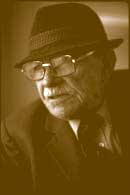 "We rode the lad to the train station in a pony cart," Captain Cumiskey said of Buster, "and there were a few tears shed that day, I can tell you. He was a little scrapper and we all loved him."
"We rode the lad to the train station in a pony cart," Captain Cumiskey said of Buster, "and there were a few tears shed that day, I can tell you. He was a little scrapper and we all loved him."
Captain Cumiskey also knew or remembered all the Campbells; plus that the name, Campbell, meant "one with a crooked mouth." He said that at several town hall parties he danced with Aunt Essie, my mother's youngest sister, and on one occasion went so far as to kiss her. After two stiff whiskeys, he even "remembered" dancing with Mother when she came back to Ireland to drop off Buster and me—I've since found out from other relatives that the Captain wasn't shy when it came to spinning yarns. So, what's real and what isn't is always in question. Nonetheless, Captain Cumiskey mostly had stories about his friend, Uncle Willie.
It's said, of my mother's four brothers—Patrick, Richard, William, and Laurence—Uncle Willie was the most head strong. Captain Cumiskey—known to have "had a fling from time to time meself"—once worked beside Willie in the fields and tipped back many a pint with him after a day on the job. In fact, they were drinking buddies up until the day Cumiskey joined the Irish Army, about the same time William left for the States.
As for flings: the Captain said that at one time Willie fell for a Mary Anne—the Captain couldn't remember her maiden name—but she was promised to a much older Protestant: Mr. Gorman. Heartbroken, Willie sailed for New York, but didn't take to the States, and returned to Britain to join the British Navy. Some years later, however, after having a son with Mary Anne—a boy named Jamesy who died at the age of thirty-nine from rheumatoid arthritis and kidney failure, but whose daughters still live in Ireland to this day—Mr. Gorman died. He worked onboard a ship and, one winter while the ship was docked in Dún Laoghaire, he slipped on black ice covering the mast and fell to his death. He left behind...The Widow Gorman.
Captain Cumiskey wasn't clear on dates, but at some point after Mr. Gorman's demise, Willie moved back to Termonfeckin, took up with the Widow Gorman and married her, finally consummating his long unrequited love. Willie and Mary Anne stayed together until their deaths (both in Ireland), and had two children, Mary—she married a Stephen Garvey, moved to the States, but still regularly visits her Irish relatives—and Patrick.
(*For more names and information on my mother's brothers and sisters, see Footnotes!)
Back in Termonfeckin, Captain Cumiskey also claimed he remembered how Grandfather Patrick drank away the family farm, and even hinted that Grandma Mary was overly familiar with the bottle, herself. But, as I've said, the Captain suffered from another Irish condition that comes from having kissed the Blarney Stone, so his "claims" are shaky at best. Grandpa Patty, however, did lose the farm. That much is known for certain.
Anyhow, there are way too many Patricks in my Campbell Clan; I don't know how anyone keeps them straight. But, for my purposes, the first one anyone knows of is the one that counts. He was born in 1760, according to dates on the Campbell's gravestone. His age coincides with a diaspora of Scottish people, swarms of farmers who left like "bees rising from the fields" as one historian observed. It was a period in Scotland's history when Catholics were leaving due to Protestant ascendancy. The Protestant lords and landowners, who preferred to rent their properties to the wealthier Lowland and English sheep farmers, began to charge exorbitant rents to the Catholic Highlanders. Evictions became prevalent; resulting in many families being dispossessed and dispersed. They left for Ireland, the States, Canada, and even Australia; a mass depopulation of the Scottish Highlands. And I think one of those displaced souls was my great-great-grandfather: Patrick Campbell...the First!
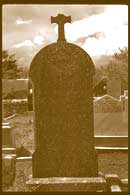 By whatever means Patriarch Pat came to Termonfeckin it appears he set about to find himself a wife and start a family. Her name was Anne, six years his junior, but I've learned nothing else specifically about her, except what the family marker has to say (see below). I do know that Patrick and Anne lived in Newtown, an old Catholic colony abutting Termonfeckin on the south, and together they reared three children: Mary, born in 1797; William, my great-grandfather, born in 1806; and Richard, born in 1811.
By whatever means Patriarch Pat came to Termonfeckin it appears he set about to find himself a wife and start a family. Her name was Anne, six years his junior, but I've learned nothing else specifically about her, except what the family marker has to say (see below). I do know that Patrick and Anne lived in Newtown, an old Catholic colony abutting Termonfeckin on the south, and together they reared three children: Mary, born in 1797; William, my great-grandfather, born in 1806; and Richard, born in 1811.
It was Great-grandfather William who originally commissioned the family gravestone, what is now a large, lichen-encrusted, weather-worn, nearly illegible granite marker that is missing the top arm of it's "celtic cross" (a true Celtic Cross has a ring circumscribing the arms of the cross. To appease the "new" religions, however, the circle was broken, yet left the ends of the arms arced). The stone stands in the Catholic cemetery in the Mayne parish. Subsequently, it also came to include William's own date of death, as well as my grandfather's, the last Campbell mentioned.
Here is a facsimile of the information as it is codified on the stone:
Wm Campbell of Newtown, Termonfeckin
in memory of his mother Anne who died
20th December 1813
Aged 44 years
of his father Patrick who died
12th December 1843
83 years
Sister Mary
8 May 1848 Age 51 yrs
Brother Richard 20th May 1882
Age 71 yrs
Wife Bridget 8th August 1886
Age 79 yrs
Grandson Charles 16th March 1886
Age 20 yrs
William 8th November 1890 84 yrs
& son Pat 13 March 1915 Age 72 yrs
It was my Uncle Patrick who sailed to Ireland in 1915 to arrange and pay for my Grandfather Pat's funeral; the last Campbell listed on the stone. Almost everyone else emigrated, Willie being the exception.
At any rate, the Campbell saga continues: Great-grandpa William married one Bridget Maguire, born in 1807, and together they had my Grandfather Patrick in 1843. He married my Grandmother Mary, the daughter of Laurence Reynolds and Marge Flynn, sometime before 1880 (the Reynolds had a Termonfeckin farm, too, which to this day locals still refer to as the Reynolds' farm). Of course, then Patrick and Mary set about to create my Campbell clan. Essie was the youngest and May Bridget was the oldest. In between came William, Patrick Jr, Richard, Laurence, and my mother, Margaret, squeezed in there somewhere. The exact order is open for interpretation...
During the Captain's tour, Cumiskey pointed out the land—fecund acres still under cultivation—that once belonged to the Campbell Clan. All the buildings were gone, but Cumiskey said it was one of the best farms in the region, the legacy of three generations of hardworking Campbells. Grandpa Patty probably assumed control of the property sometime before his father's death, but inherited it for sure in 1890, when the patriarch passed-on. Then, like it or not, and in that grand old tradition of Irish alcoholics, it appears Patty drank up the profits, until the government confiscated the land for failure to pay taxes. And, supposedly, the disgruntled landlord bought the farm at auction so Campbells would never have a second chance to get their hands on it. And, as you might suspect, it was about that time that the Campbell kids started leaving for America.
When Buster was staying with Grandma Mary, she lived in one half of a small, stucco duplex, the second after the farm—they measured time that way: "houses after the farm." The first house after the farm was a small, rickety, thatched cottage close by Captain Cumiskey's—it no longer exists and barely existed while the Campbell's lived in it—no wonder they left for the promise of the New World.
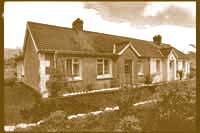 I can't imagine the vexation and embarrassment Grandma Mary must have suffered upon losing her wonderful farmhouse only to move into a pauper's hut—Irish pride is very strong. At least the second house after the farm—the one reeking of boiling potatoes—was a clean, sturdy little duplex (if you look back to the picture of her in chapter one, you'll see that she's standing between those two front windows). But, after the loss of her beloved farmhouse, or so the Captain claimed, Grandma Mary began to enjoy the spirits quite a bit herself; although she lived a long life, even traveled to the States in the '20s with one of her children—I don't know who.
I can't imagine the vexation and embarrassment Grandma Mary must have suffered upon losing her wonderful farmhouse only to move into a pauper's hut—Irish pride is very strong. At least the second house after the farm—the one reeking of boiling potatoes—was a clean, sturdy little duplex (if you look back to the picture of her in chapter one, you'll see that she's standing between those two front windows). But, after the loss of her beloved farmhouse, or so the Captain claimed, Grandma Mary began to enjoy the spirits quite a bit herself; although she lived a long life, even traveled to the States in the '20s with one of her children—I don't know who.
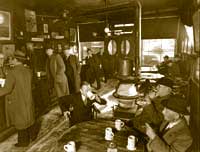 As for the Campbell kids and how they did in America, Captain Cumiskey claimed "Patty got stinkin' rich over there," although he couldn't remember how. But, Patty's money not only paid for his father's burial, it also allowed other Campbell's to emigrate. Cumiskey wasn't positive, but he thought it was Laurence, or Larry or Lar, who wound up owning a Bronx pub, called the Bainbridge Cafe (which I believe is still there). And, as Irish luck would have it, after a very busy subway station was constructed near the pub, Lar became fairly wealthy himself.
As for the Campbell kids and how they did in America, Captain Cumiskey claimed "Patty got stinkin' rich over there," although he couldn't remember how. But, Patty's money not only paid for his father's burial, it also allowed other Campbell's to emigrate. Cumiskey wasn't positive, but he thought it was Laurence, or Larry or Lar, who wound up owning a Bronx pub, called the Bainbridge Cafe (which I believe is still there). And, as Irish luck would have it, after a very busy subway station was constructed near the pub, Lar became fairly wealthy himself.
When Patrick traveled back to Termonfeckin in 1915 for Grandfather Pat's funeral, Captain Cumiskey had a chance to become acquainted with the older man. Cumiskey was impressed with Patrick, and made a point of telling my son all the things Patrick did upon his return to Termonfeckin. First, he purchased new dresses for his mother and Essie, plus a suit for Lar. Next, he paid to have the family plot tidied and manicured for the funeral, plus the last line carved in the gravestone. Then he bought an expensive coffin, paid for the service and the burial, but more importantly: the wake!
"By then, everyone was impressed with him," quipped Cumiskey.
During his stay, Patrick and Cumiskey spent a lot of time together (and this might be where Captain Pete was created, his name acquiring the "Captain" after his promotions in the Irish Army). The two of them shared stories, catching each other up on Termonfeckin and Stateside news. They also rode together in a horse-drawn trap when the funeral procession traveled from the Catholic church in Termonfeckin to the family plot at Port Cemetery, several kilometers outside town. And then they went to the wake together. Being only fifteen at the time, however, wiser heads wouldn't allow young Cumiskey, much to his dismay, to "join in" as much as he would have liked; not saying he didn't "join in" at all, just not as much as he would have liked.
"But, I'll tell you," he said, "it was one of the grandest wakes the town ever knew. Many a soul suffered for it the next day..."